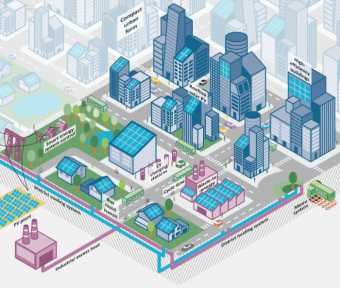 Cities dominate energy demand, and by extension are responsible for a significant share of carbon emissions. In 2013, the world’s urban areas accounted for about 64% of global primary energy use and produced 70% of the planet’s carbon dioxide emissions. These shares will rise as cities grow and urban economic activity expands. As the world seeks to make more efficient use of its energy resources, increase energy security and meet global climate targets, it is essential that cities take a leading role in the energy transition.
Cities dominate energy demand, and by extension are responsible for a significant share of carbon emissions. In 2013, the world’s urban areas accounted for about 64% of global primary energy use and produced 70% of the planet’s carbon dioxide emissions. These shares will rise as cities grow and urban economic activity expands. As the world seeks to make more efficient use of its energy resources, increase energy security and meet global climate targets, it is essential that cities take a leading role in the energy transition.
Thankfully, there are a wide range of solutions for reducing the carbon footprint and improving the energy efficiency of urban areas. For example, according to IEA analysis presented in the special section on urban energy systems in Energy Technology Perspectives 2016 (ETP 2016) the gradual evolution of urban transport systems to encourage walking, cycling and public transit could save $21 trillion by 2050, while at the same time making a significant dent in greenhouse gas emissions. But the longer action is delayed, the greater the chances that inefficient choices will be “locked-in” for decades to come. This focus on urban energy systems in ETP 2016 provides policymakers at both national and local levels the tools and analysis necessary to set realistic targets to encourage immediate action.
Policy at the national level must encourage the deployment of clean energy technologies, and include greenhouse gas emission reduction targets (such as those under the Paris Agreement), carbon pricing mechanisms, and investment in energy research, development and demonstration.
But these targets must then be complemented by action at the local level. To meet their renewable energy targets, cities can provide detailed solar maps giving valuable information on expected energy yields and installation costs for buildings and houses in various neighbourhoods for example. On transportation and fossil fuel emissions, cities can also invest in the long-term development of walking and cycling infrastructure. For energy efficiency, cities can take a leading role in adopting, monitoring and enforcing building energy codes for new construction.
There are cities that are already taking serious action. Some small towns in the United States are already running entirely on renewable power, including Aspen, Colorado, and Burlington, Vermont. Bigger cities have set ambitious goals, with Copenhagen, Denmark, aiming to be carbon neutral by 2025. San Diego, California, aims to be 100% powered by renewable sources by 2035, and Vancouver, Canada, by 2050.
Even some of the world’s biggest cities are seeing encouraging results. Yokohama is the second-largest city in Japan with a population of 3.7 million and like many other cities in the world, rapid urbanisation has increased energy use, caused traffic jams, and led to spikes in air pollution and greenhouse gas emissions. In 2010, the city decided to tackle the issue and improve its energy management, doing its part to mitigate climate change. The Yokohama Smart City Project began as a five-year pilot in three districts. It has since been deployed to the entire city, covering about 435 square kilometres. The project uses smart grids to manage the energy needs of households, buildings and local communities. It introduced about 37 megawatts of solar PV generation spread over 265 locations across the city (enough to power more than 9 000 Japanese households) has deployed over 2,000 electric vehicles, and has seen great success in using incentives to limit electricity use.
There is growing momentum behind the role of the city in taking action on climate and sustainability. Ten years ago the C40 Cities Climate Leadership Group was established as a global network of cities that are developing and implementing policies to reduce emissions. Today, the C40 network consists of more than 75 cities, representing more than 550 million people. As part of the C40 network, Paris has committed to reducing CO2 emissions in municipal buildings, in part by undertaking deep renovations of 600 public schools to save 65 gigawatt hours of electricity per year. More than 2 000 of such measurable actions have been taken by C40 cities around the globe.
Cities are naturally positioned to make these kinds of changes. The density of human, economic and intellectual capital in the world’s cities can be a driving force for the acceleration of clean energy development and deployment. As more and more cities take the opportunity to act as innovation hubs and test beds for sustainable urban energy technology, the closer the whole world will be to providing secure, sustainable and affordable energy for all.
Source: iea.org



